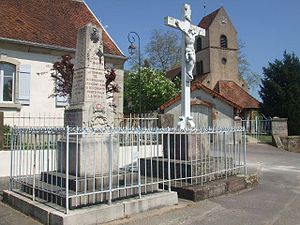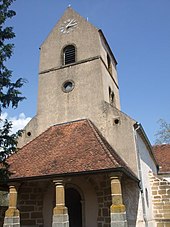Bourguignon-lès-Conflans
| Bourguignon-lès-Conflans | ||
|---|---|---|
|
|
||
| region | Bourgogne-Franche-Comté | |
| Department | Haute-Saône | |
| Arrondissement | Vesoul | |
| Canton | Port-sur-Saône | |
| Community association | Terres de Saône | |
| Coordinates | 47 ° 48 ' N , 6 ° 10' E | |
| height | 217-310 m | |
| surface | 8.02 km 2 | |
| Residents | 141 (January 1, 2017) | |
| Population density | 18 inhabitants / km 2 | |
| Post Code | 70800 | |
| INSEE code | 70087 | |
 Bourguignon-lès-Conflans |
||
Bourguignon-lès-Conflans is a commune in the French department of Haute-Saône in the region Bourgogne Franche-Comté .
geography
Bourguignon-lès-Conflans is located at an altitude of 227 m above sea level, six kilometers northeast of Faverney and about 21 kilometers north of the city of Vesoul (as the crow flies). The village extends in the northern part of the department, in the wide valley of the Lanterne , on the northern bank of the river.
The area of the 8.02 km² municipal area comprises a section in the gently undulating landscape north of the Lanterne valley plain. The southern border runs along the Lanterne, which here flows with several turns through an alluvial lowland to the west to the Saône . The valley level lies at an average of 220 m and has a width of around 5 kilometers. It is partly used for agriculture, partly with forest. In the area of Bourguignon, the Lanterne reaches three streams from the north: the Ruisseau des Canes (in sections the western border), the Ruisseau de l'Étang and the Ruisseau de la Biffotte (marks the eastern border in parts ).
From the course of the river, the municipal area extends northward over the floodplain to the adjacent hills and into the extensive forest of Socheux et Clair-Bois on the southern roof of Mont d'Olivette . The highest point in Bourguignon-lès-Conflans is reached here at 310 m. From a geological and tectonic point of view, the area consists of alternating layers of sandy-marl and calcareous sediments that were deposited during the Lias ( Lower Jurassic ). Shell limestone from the Middle Triassic also appears in some places .
Neighboring municipalities of Bourguignon-lès-Conflans are Dampierre-lès-Conflans in the north, Bassigney and Conflans-sur-Lanterne in the east, Mersuay in the south and Cubry-lès-Faverney in the west.
history
Bourguignon probably already existed in the 5th century. In the Middle Ages, the village belonged to the Free County of Burgundy and in that part of the Bailliage d'Amont . Local rule had been held by the lords of Lomont since 1185 and the Cicon family since the 14th century. Bourguignon was dependent on the coming of La Villedieu-en-Fontenette. Together with Franche-Comté , the place finally came to France with the Peace of Nijmegen in 1678.
Attractions
The Saint-Georges church is classified as a monument historique and shows building elements from different epochs. The Gothic choir dates from the 14th century, the nave from the 16th century. The remarkable furnishings include the main altar, the tabernacle, paintings and the host vessel from the 18th century.
The castle was built in the 14th and 15th centuries. Other attractions include several fountains, various houses from the 18th and 19th centuries that show the traditional style of the Haute-Saône, the Mairie-École (municipal administration and school) from 1875 and a cast iron bridge (1849) over the Lantern .
population
| Population development | |
|---|---|
| year | Residents |
| 1962 | 114 |
| 1968 | 113 |
| 1975 | 93 |
| 1982 | 95 |
| 1990 | 89 |
| 1999 | 106 |
| 2006 | 118 |
With 141 inhabitants (January 1, 2017), Bourguignon-lès-Conflans is one of the small communities in the Haute-Saône department. After the population had decreased significantly in the first half of the 20th century (268 people were counted in 1896), slight population growth has been recorded since the beginning of the 1990s.
Economy and Infrastructure
Until well into the 20th century, Bourguignon-lès-Conflans was a village dominated by agriculture (arable farming, fruit growing and cattle breeding) and forestry. Today there are some local small businesses. In the last few decades the village has transformed into a residential community. Many workers are therefore commuters who work in the larger towns in the area.
The village is located away from the major thoroughfares on a department road that leads from Faverney to Conflans-sur-Lanterne. Further road connections exist with Cubry-lès-Faverney and Bassigney.

